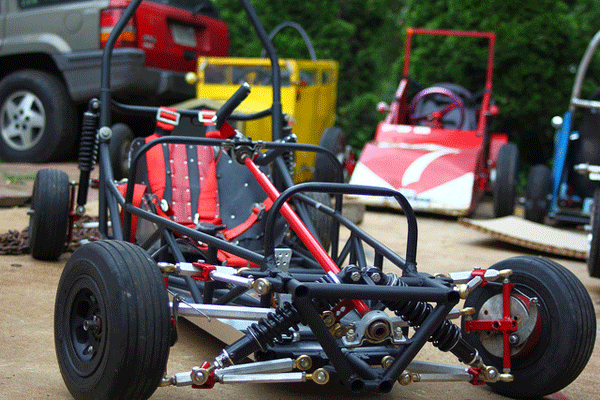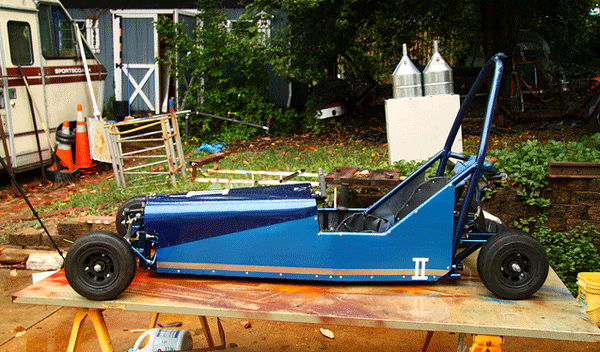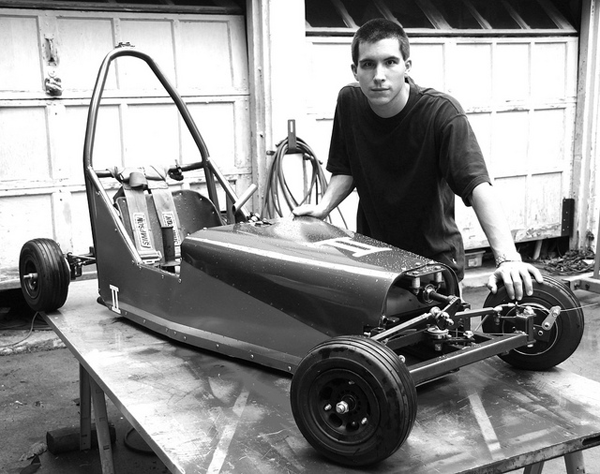

1. How did you get started building soapbox cars?
First I became interested in driving soapbox karts (on a whim). Then, before I’d even gotten in one, I concluded that I absolutely must make one for myself that I could build, tweak, race, break, rebuild, and be responsible for. I’ve always loved making things, so wanting to build a kart came as naturally to me as wanting to play with Legos when I was a kid.
2. You’re a member of the Maryland MISFITS. Do you work on builds with others from the club or just race together? How does being a part of the club inform and inspire you?
Actually, I just helped a member of Harford Hackerspace build a kart, which he raced on May 8. The MISFITS is a small group (but looking for more drivers!), so it’s beneficial to help others who might not have as much experience or direction in what they want. Most of our karts are made out of one garage with as much or as little help from others as you want. My Weekend Warrior was a solo project per my insistence, but the recently completed Biohazard had as many as a half dozen people participate in its construction at some point. I enjoy helping others out on their karts, and I’ve even taught the hackerspace member how to weld.
3. What’s an “illegal” derby/federation?
I think you covered that perfectly on page 66 of MAKE Volume 26. It’s soapbox racing for adults, where the karts can have a lot of personality, where everyone races as one big group, and where you drive on real roads with real turns. It’s a good excuse to keep having fun like you had as a kid.
4. What’s the fastest speed you’ve clocked in your soapbox car? What’s the golden rule of handling/maneuvering a kart at high speeds?
I’ve personally clocked 59 in this kart, 60 in my more race-oriented kart, Weekend Warrior II [pictured below]. I do know some out in California or Australia are seeing higher speeds, so I’m by no means the final say on what all the speed secrets are, not even close. When you’re up at that high speed, though, you have to remember that your gravity-powered soapbox kart is not a big comfy car. You don’t have power steering or brakes, ABS, traction control, airbags, or even a gas pedal. At that speed, the golden rules are don’t drive over your head and don’t do anything sudden. If you panic and lay on the brakes, you’ll suddenly be facing backwards. Jerk the wheel and you’ll get acquainted with the nearest tree. Also, don’t try to go 80 your first time out. Don’t go 60 without knowing what 55 feels like in a gravity kart, and don’t do 55 without knowing what 50 feels like.
5. Your Weekend Warrior was meticulously documented (awesome pics!). What inspired you to document your build?
Well I love sharing knowledge, and I always liked looking at the pictures of the karts from the other soapbox groups to see what I could learn and what other neat stuff people were doing. I’d tried on a previous build to document things well and didn’t succeed. I wanted to do it right this time, so others could learn from my build process, and because this kart is in the minority among soapboxers in that it has suspension. Also, I like using a camera.
6. Tell us about yourself. How did you get started making things and who are your inspirations?
I don’t even remember how I got started making things. Our basement back home in Connecticut was always full of Dad’s woodworking tools and bags of scrap laying around that I would nail and glue together. Then, there were Legos, and K’Nex, and Erector sets. I guess it’s only natural that now I’ve progressed to cutting and welding. The one inspiration I’d have to say above anyone else is my father. He’s made countless beautiful cabinets and pieces of furniture for our family, he used to work on cars, he owns his own renovation business, he’s always let me use the tools when I asked, and as much as it may have felt otherwise at the time, he never held me back from making what I wanted to make, be it a model railroad, rockets, computers, or a stereo. Thanks, Dad.
7. What new idea in soapbox cars and derbies has excited you most recently?
Drivers going far outside their normal area to ride hills. Recently some Australians, a guy from New Jersey, and soon someone from Wisconsin have gotten to run with some of the Southern California guys. Last fall some of those guys from SoCal came out to Pennsylvania to compete in a 6-hill day of competition called the East Coast Challenge, and they routinely take days-long “soapbox safaris” to hills they’ve never driven all along the West Coast. Even thousands of miles aren’t stopping us from high-speed gravity-powered fun with others who share the same interest.
8. What is your motto?
Have fun. Some people are in it for the competition, but I just like to build stuff and have a great time on the hill.
9. What advice would you give to folks interested in getting involved in soapbox derbies?
Find a group in your area and spectate, drive loaner karts, etc, until you get yours built! And if there’s not a group in your area, find a few people as crazy as you are and start building. You’d be surprised how many people would love to race gravity karts as adults but never thought it was possible.
10. What is your most prized tool?
My favorite tool to use in the shop is by far the lathe. It may take a long time to get anything done on it, and most of the time you’re standing around waiting for the auto-feed to finish doing what it’s doing, but there’s just so much you can do on it, and it makes you take your time, slow down, and think about how everything’s going to come together. However, I don’t own the tools in the shop, so my most prized tool that I own would have to be the good old Leatherman Wave. There hasn’t been a day working on this kart when I haven’t broken it out at some point.
From the Pages of MAKE:
MAKE Volume 26: Karts & Wheels
Garage go-kart building is a time-honored tradition for DIYers, In this issue of MAKE, we’ll show you how to build wheeled wonders that’ll have you and the kids racing around the neighborhood in epic DIY style. Build a longboard skateboard by bending plywood and build a crazy go-kart driven by a pair of battery-powered drills. Put a mini gasoline engine on a bicycle. And construct an amazing wind-powered cart that can outrun a tailwind. Plus you’ll learn how to build the winning vehicle from our online Karts and Wheels contest! In addition to karts, you’ll find plenty of other projects that only MAKE can offer!
ADVERTISEMENT










